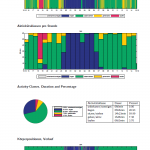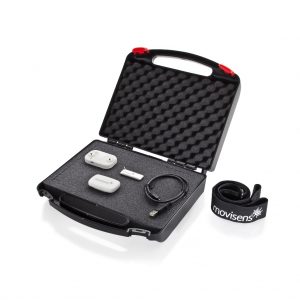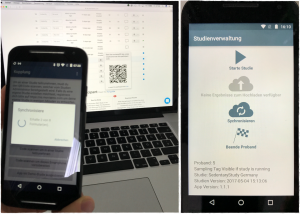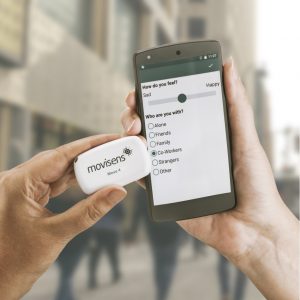Influence of motivational interviewing on postoperative mobilization in the enhanced recovery after surgery (ERAS®) pathway in elective colorectal surgery - a randomized patient-blinded pilot study.
R. Wiesenberger & J. Müller & M. Kaufmann et al. (2024)
in: Langenbecks Arch Surg (409).
Read more...Impact of a Semi-Rigid Knee Orthotic Intervention on Pain, Physical Activity, and Functional Capacity in Patients with Medial Knee Osteoarthritis.
B. J. Stetter & J. Fiedler & M. Arndt et al. (2024)
in: Journal of Clinical Medicine (13 (6)).
Read more...Psychomotor Slowing in Psychosis and Inhibitory Repetitive Transcranial Magnetic Stimulation.
S. Walther & D. Alexaki & F. Weiss et al. (2024)
in: JAMA Psychiatry.
Read more...Exploring the Link between Lifestyle, Inflammation, and Insulin Resistance through an Improved Healthy Living Index.
F. Bruckner & J.R. Gruber & A. Ruf et al. (2024)
in: MDPI (16(3)).
Read more...Development of a Machine Learning Model to Detect Freezing of Gait in Parkinson Patients.
Determination of cut-off points for the Move4 accelerometer in children aged 8–13 years.
F. Beck & I. Marzi & A. Eisenreich et al. (2023)
in: BMC Sports Science, Medicine and Rehabilitation (15, 163).
Read more...Momentary within-subject associations of affective states and physical behavior are moderated by weather conditions in real life: an ambulatory assessment study.
I. Timm & M. Reichert & U. Ebner-Priemer et al. (2023)
in: International Journal of Behavioral Nutrition and Physical Activity (20).
Read more...Microtemporal Dynamics of Dietary Intake, Physical Activity, and Impulsivity in Adult Attention-Deficit/Hyperactivity Disorder: Ecological Momentary Assessment Study Within Nutritional Psychiatry.
A. Ruf & A. B. Neubauer & E. D. Koch et al. (2023)
in: JMIR Publications (10).
Read more...Ecological Momentary Assessment in Nutritional Psychiatry: Microtemporal Dynamics of Dietary Intake, Physical Activity, and Impulsivity in Adult ADHD.
A. Ruf & A. B. Neubauer & E. D. Koch et al. (2023)
in: JMIR Mental Health.
Read more...Momentary associations between sedentary bouts, cognitive load and mood in daily life: An ambulatory assessment study.
M. Giurgio & U. Ebner-Priemer (2023)
in: Mental Health and Physical Activity (25).
Read more...The Work Lifestyle-integrated Functional Exercise Program for Preventing Functional Decline in Employees over 55 years: Development and Initial Evaluation.
Y. Ritter & D. Pfister & G.M. Steckhan et al. (2023).
Read more...Multicentre, interventional, single-arm study protocol of telemonitored circadian rhythms and patient-reported outcomes for improving mFOLFIRINOX safety in patients with pancreatic cancer.
M. Bouchahda & A. Ulusakarya & A. Thirot-Bidault et al. (2023)
in: BMJ Open (13(6)).
Read more...Microstructural white matter biomarkers of symptom severity and therapy outcome in catatonia: Rationale, study design and preliminary clinical data of the whiteCAT study.
D. Hirjak & G.A. Brandt & R. Peretzke et al. (2023)
in: Schizophrenia Research.
Read more...Combined physical activity training versus aerobic activity training in unipolar depressive disorder: a quasi-randomised evaluation study.
A. Berwinkel & M. Driessen & T. Beblo et al. (2023)
in: Neuropsychiatr.
Read more...At Crossroads in a Virtual City: Effect of Spatial Disorientation on Gait Variability and Psychophysiological Response among Healthy Older Adults.
C. O. Amaefule & S. Lüdtke & A. Klostermann et al. (2022)
in: Gerontology.
Read more...The 8th International Conference on Ambulatory Monitoring of Physical Activity and Movement: Active and Sitting Time Precursors to Mood in Young Adults.
B. Clark & E. Winkler & M. Giurgio et al. (2022)
in: Journal for the Measurement of Physical Behaviour (5; 4).
Read more...Effects of strength exercise interventions on activities of daily living, motor performance, and physical activity in children and adolescents with leukemia or non-Hodgkin lymphoma: Results from the randomized controlled ActiveADL Study.
D. Gaser & C. Peters & R. Oberhoffer-Fritz et al. (2022)
in: Frontiers in Pediatrics.
Read more...Effectiveness of an evidence-based care pathway to improve mobility and participation in older patients with vertigo and balance disorders in primary care (MobilE-PHY2): Study protocol for a multicentre cluster-randomised controlled trial.
C. Horstmannshoff & S. Skudlik & J. Petermann et al. (2022)
in: Research Square.
Read more...The Behavioral Mapping of Psychomotor Slowing in Psychosis Demonstrates Heterogeneity Among Patients Suggesting Distinct Pathobiology.
N. Nadesalingam & S. Lefebvre & D. Alexaki et al. (2022).
Read more...Measuring catatonia motor behavior with objective instrumentation.
S. von Känel & N. Nadesalingam & D. Alexaki et al. (2022)
in: Frontiers in Psychology.
Read more...Mood-enhancing Physical Activity in Individuals with Attention-Deficit/Hyperactivity Disorder (ADHD) and Healthy Youths – Daily Life Investigations by Ambulatory Assessment.
A temporal classification method based on behavior time series data in patients with behavioral variant of frontotemporal dementia and apathy.
C. Peltier & F. Lejeune & L.G.T. Jorgensen et al. (2022)
in: Journal of Neuroscience Methods (376).
Read more...The association of stress and physical activity: Mind the ecological fallacy.
M. Reichert & S. Brüßler & I. Reinhardt et al. (2022)
in: German Journal of Exercise and Sport Research (52).
Read more...Influence of Sit-Stand Tables in Classrooms on Children’s Sedentary Behavior and Teacher’s Acceptance and Feasibility: A Mixed-Methods Study.
P. Schwenke & M. Coenen (2022)
in: Environmental Research and Public Health (19 (11)).
Read more...Sleep quality, valence, energetic arousal, and calmness as predictors of device-based measured physical activity during a three-week mHealth intervention.
J. Fiedler & C. Seiferth & T. Eckert et al. (2022)
in: German Journal of Exercise and Sport Research.
Read more...Equivalency of four research-grade movement sensors to assess movement behaviors and its implications for population surveillance.
J.H. Migueles & P. Molina-Garcia & L.V. Torrez-Lopez et al. (2022)
in: Scientific Reports (12).
Read more...Analysis of self-reported activities of daily living, motor performance and physical activity among children and adolescents with cancer: Baseline data from a randomised controlled trial assessed shortly after diagnosis of leukaemia or non-Hodgkin lymphoma.
D. Gaser & C. Peters & M. Götte et al. (2022)
in: Wiley.
Read more...Functional connectivity correlates of reduced goal-directed behaviorsin behavioural variant frontotemporal dementia.
V. Godefroy & B. Batrancourt & S. Charron et al. (2022) in: Research Square. Read more...
Actigraph-Measured Movement Correlates of Attention-Deficit/Hyperactivity Disorder (ADHD) Symptoms in Young People with Tuberous Sclerosis Complex (TSC) with and without Intellectual Disability and Autism Spectrum Disorder (ASD).
T. Earnest & E. Shephard & C. Tye et al. (2020)
in: Brain Sciences (8).
Read more...Accuracy of Sedentary Behavior–Triggered Ecological Momentary Assessment for Collecting Contextual Information: Development and Feasibility Study.
M. Giurgiu & C. Niermann & U. Ebner-Priemer et al. (2020) in: JMIR mHealth and uHealth (8).
Mood and dysfunctional cognitions constitute within - subject antecedents and consequences of exercise in eating disorders.
M. Reichert & S. Schlegel & F. Jagan et al. (2020) in: Psychotherapy and Psychosomatics (89).
OREBA: A Dataset for Objectively Recognizing Eating Behaviour and Associated Intake.
P.-V. Rouast & H. Heydarian & M.-T.-P. Adam et al. (2020).
Improving mobility and participation of older people with vertigo, dizziness and balance disorders in primary care using a care pathway: feasibility study and process evaluation.
E. Seckler & V. Regauer & M. Krüger et al. (2020) in: Research Square.
Fear of Physical Activity, Anxiety, and Depression. Barriers to Physical Activity in Outpatients With Heart Failure?.
H. Spaderna & J. M. Hoffmann & S. Hellwig et al. (2020)
in: European Journal of Health Psychology (27).
Read more...The Freiburg sport therapy program for eating disorders: a randomized controlled trial.
A Zeeck & S. Schlegel & F. Jagan et al. (2020)
in: Journal of Eating Disorders (8).
Read more...A neural mechanism for affective well-being: Subgenual
cingulate cortex mediates real-life effects
of nonexercise activity on energy.
R. Markus & U. Braun & G. Gan et al. (2020) in: Science advances (6).
Development of a classification system for assessing apathy’s degree in patients with behavioral variant of frontotemporal dementia.
P. Fulcher (2020) in: MASTER’S DEGREE THESIS.
Validating Accelerometers for the Assessment of Body Position and Sedentary Behavior.
M. Giurgiu & J.B.J. Bussmann & H. Hill et al. (2020)
in: Journal for the Measurement of Physical Behaviour (Volume 3: Issue 3).
Read more...Breaking Up Sedentary Behavior Optimally to Enhance Mood.
M. Giurgio & E.D. Koch & R.C. Plotnikoff et al. (2020) in: Medicine & Science in Sports & Exercise (52).
Real-Time Detection of Spatial Disorientation in Persons with Mild Cognitive Impairment and Dementia.
J. Schaat & P. Koldrack & K. Yordanova et al. (2019) in: Gerontology (1).
Dynamics of Intraindividual Variability in Everyday Life Affect Across
Adulthood and Old Age.
M. Katana (2019).
Embodied learning in the classroom: Effects on primary school children's attention and foreign language vocabulary learning.
M. Schmidt & V. Benzig & A. R. Wallman-Jones et al. (2019)
in: Psychology of Sport and Exercise (43).
Read more...Neural correlates of individual differences in affective benefit of real-life urban green space exposure.
Heike Tost & Markus Reichert & Urs Braun et al. (2019)
in: Nature Neuroscience (7).
Read more...Using Acceleration Data for Detecting Temporary Cognitive Overload in Health Care Exemplified Shown in a Pill Sorting Task.
L. Kohout & M. Butz & W. Stork (2019) in: 2019 IEEE 32nd International Symposium on Computer-Based Medical Systems (CBMS).
Sedentary behavior in everyday life relates negatively to mood: An ambulatory Assessment study.
Marco Giurgiu & Elena D. Koch & Jörg Ottenbacher et al. (2019)
in: Scandinavian Journal of Medicine & Science in Sports (29).
Read more...Promotion of physical activity-related health competence in physical education: study protocol for the GEKOS cluster randomized controlled trial.
Stephanie Haible & Carmen Volk & Yolanda Demetriou et al. (2019)
in: BMC Public Health (19).
Read more...Energy Expenditure During Incline Walking – Benefits of Integrating a Barometer into Activity Monitors.
M. Armbruster & P. Anastasopoulou & S. Altmann et al. (2018)
in: American Journal of Sports Science (6).
Read more...Individual Differences in the Competence for Physical-Activity-Related Affect Regulation Moderate the Activity–Affect Association in Real-Life Situations.
Gorden Sudeck & Stephanie Jeckel & Tanja Schubert (2018)
in: Journal of Sport and Exercise Psychology (40).
Read more...Intermittent Fasting (Alternate Day Fasting) in Healthy, Non-obese Adults: Protocol for a Cohort Trial with an Embedded Randomized Controlled Pilot Trial.
Norbert J. Tripolt & Slaven Stekovic & Felix Aberer et al. (2018)
in: Advances in Therapy (35).
Read more...Bright light therapy versus physical exercise to prevent co-morbid depression and obesity in adolescents and young adults with attention-deficit / hyperactivity disorder: study protocol for a randomized controlled trial.
Jutta S. Mayer & Katharina Hees & Juliane Medda et al. (2018)
in: Trials (19).
Read more...A novel algorithm for detecting human circadian rhythms using a thoracic temperature sensor Article history :.
Aly Chkeir & Farah Mourad-chehade & Jacques Beau et al. (2017)
in: Advances in Science, Technology and Engineering Systems Journal (2).
Read more...Physical Activity and Depressive Mood in the Daily Life of Older Adults.
Andrea E. Gruenenfelder-Steiger & Marko Katana & Annika A. Martin et al. (2017) in: GeroPsych (30). Read more...
Measuring Fear of Physical Activity in Patients with Heart Failure.
Jeremia M. Hoffmann & Susan Hellwig & Vincent M. Brandenburg et al. (2017)
in: International Journal of Behavioral Medicine (25).
Read more...Lightweight Visual Data Analysis on Mobile Devices - Providing Self-Monitoring Feedback.
Simon Butscher & Yunlong Wang (2016)
in: VVH 2016 - 1st International Workshop on "Valuable visualization of healthcare information": from the quantified self data to conversations (in conjunction with AVI '16).
Read more...Contributions à l’élaboration d’un système d’aide médico-sociale à l’aide d’un robot humanoïde.
Situationsadaptive Navigationsassistenz für Menschen mit Demenz.
P. Koldrack & R. Henkel & K. Zarm et al. (2015)
in: AAL-Kongress 2015.
Read more...Real-Time Management of Multimodal Streaming Data for Monitoring of Epileptic Patients.
Dimitrios Triantafyllopoulos & Panagiotis Korvesis & Iosif Mporas et al. (2015)
in: Journal of Medical Systems (40).
Read more...Bewegungsangst bei chronischer Herzinsuffizienz – Erste Ergebnisse zur Validierung eines Messinstruments.
H. Spaderna & S. Hellwig & D. Hennig et al. (2015)
in: 12. Kongress der Fachgrupppe Gesundheitspsychologie - Abstracts.
Read more...Fitness, kognitive Leistungsfähigkeit und Wohlbefinden bei jungen Erwachsenen - Interventionsstudien zum Einfluss von Ausdauertraining.
Validation and comparison of two methods to assess human energy expenditure during free-living activities.
P. Anastasopoulou & M. Tubic & S. Schmidt et al. (2014)
in: PLOS (PLoS ONE 9(2): e90606).
Read more...Erfassung körperlicher Aktivität mittels Akzelerometrie - Möglichkeiten und Grenzen aus technischer Sicht.
Stefan Hey & Panagiota Anastasopoulou & Birte von Haaren (2014)
in: Bewegungstherapie und Gesundheitssport (30(02)).
Read more...Home-based system for physical activity monitoring in patients with multiple sclerosis (Pilot study).
L. Shammas & T. Zentek & B. von Haaren et al. (2014)
in: Biomedical engineering online (13).
Read more...Detection of Parameters to Quantify Neurobehavioral Alteration in Multiple Sclerosis Based on Daily Life Physical Activity and Gait Using Ambulatory Assessment.
Layal Shammas & Birte von Haaren & Angela Kunzler et al. (2014)
in: Zeitschrift für Neuropsychologie (25).
Read more...Using Support Vector Regression for Assessing Human Energy Expenditure Using a Triaxial Accelerometer and a Barometer.
Panagiota Anastasopoulou & Sascha Härtel & Mirnes Tubic et al. (2013) in: Wireless Mobile Communication and Healthcare.
A Comparison of Two Commercial Activity Monitors for Measuring Step Counts During Different Everyday Life Walking Activities.
P. Anastasopoulou & S. Härtel & S. Hey (2013) in: International Journal of Sports Science and Engineering (Vol. 07 (2013) No. 01). Read more...
The Association between Short Periods of Everyday Life Activities and Affective States: A Replication Study Using Ambulatory Assessment.
Thomas Bossmann & Martina Kanning & Susanne Koudela-Hamila et al. (2013)
in: Frontiers in Psychology (4).
Read more...Characteristics of the activity-affect association in inactive people: an ambulatory assessment study in daily life.
B. von Haaren & S.N. Loeffler & S. Haertel et al. (2013) in: Frontiers in Movement Science and Sport Psychology (4).
Acute and medium term effects of a 10-week running intervention on mood state in apprentices.
Katrin Walter & Birte von Haaren & Simone Löffler et al. (2013)
in: Frontiers in Movement Science and Sport Psychology (4).
Read more...Measurement of daily mobility under fampridine-therapy with Movisens-system in patients with multiple sclerosis.
R. Kempcke & T. Schultheiß & S. Sobek et al. (2012) in: 28th European Committee for Treatment and Research in Multiple Sclerosis (ECTRIMS).
Kindergarten in Bewegung. Zur Qualität von Bewegungskindergärten.
R. Schwarz (2012) in: Kita aktuell.
Assessment der Mobilität im Alltag zur Unterstützung von MS-Patienten.
Shammas, L. & Bachis, S. & Anastasopoulou, P. et al. (2012) in: 15. Jahrestagung der dvs-Kommission Gesundheit, Leipzig.
Assessment of Human Gait Speed and Energy Expenditure Using a Single Triaxial Accelerometer.
Panagiota Anstasopoulou & Shammas Layal & Stefan Hey (2012)
in: Wearable and Implantable Body Sensor Networks (BSN), 2012 Ninth International Conference on.
Read more...Aktuelle Messverfahren zur objektiven Erfassung körperlicher Aktivitäten unter besonderer Berücksichtigung der Schrittzahlmessung.
D. Rosenbaum (2012)
in: Bundesgesundheitsblatt - Gesundheitsforschung - Gesundheitsschutz (55).
Read more...A new method to estimate energy expenditure using accelerometry and barometry-based energy models.
P Anastasopoulou & L. Shammas & J. Stumpp et al. (2011) in: 45. DGBMT Jahrestagung. Freiburg.
Validity of the kmsMove-sensor in calculating energy expenditure during different walking intensities.
B. von Haaren & J.-P. Gnam & S. Helmholdt et al. (2011).
Estimation of energy expenditure using accelerometers and activity-based energy models - validation of a new device.
S. Härtel & J. P Gnam & S. Löffler et al. (2011)
in: European Review of Aging and Physical Activity (Volume 8).
Read more...Trends und Möglichkeiten zur Erfassung körperlicher Aktivität im Alltag.
S. Hey & U. Großmann & J. Ottenbacher et al. (2011) in: Kinder bewegen - wissenschaftliche Energien bündeln. Jahrestagung der dvs-Kommission Gesundheit, Karlsruhe.
Bewegungskindergärten: empirische Befunde und praktisches Wissen.
R. Schwarz (2011) in: S. Baadte, K. Bös, S. Scharenberg, R. Stark, A. Woll (Hrsg.), Kinder bewegen - Energien nutzen (S. 65-75). Landau: VEP..
Energieumsatzmessung mit Aktivitätssensoren – Validität des kmsMove-Akzelerometers.
B. von Haaren & J.-P. Gnam & S. Härtel et al. (2011) in: Kinder bewegen - wissenschaftliche Energien bündeln.
Einsatz sensorgestützter Verfahren im Gesundheitswesen: Herausforderungen und Lösungsansätze.
D.I.D.S. Saboor & M.F.H.M. Schallhart (2011). Read more...














































 Step by step
Step by step



